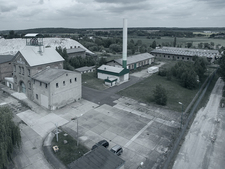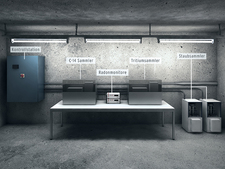Monitoring of discharges from the mine
In the context of emission monitoring controls are carried out as to what extent discharges from the Morsleben repository are radioactively contaminated. Radioactive materials can be released via both the return air and the waste water (e.g. water for a shower or washing hands) from the control area of the repository. For this reason, discharges from the mine are monitored and the measurements are documented.
As the repository operator, the Federal Office for Radiation Protection (BfS) has to prove that the limits are complied with that have been laid down in the permanent operating licence and the Radiation Protection Ordinance. The monitoring results show that the discharges of radioactive hydrogen (tritium) and radioactive carbon (C-14) are in the order of magnitude of about one per cent of the permissible discharge values. The aerosol activity, too, is always clearly below the permissible values.
Monitoring of return air

![]() Ventilation scheme of the repository (colour scheme: green = fresh air, yellow = conventional exhaust, red = potentially contaminated exhaust air; in German only)
Ventilation scheme of the repository (colour scheme: green = fresh air, yellow = conventional exhaust, red = potentially contaminated exhaust air; in German only)
In order to guarantee sufficient supply of fresh air into the mine workings, the repository needs to be ventilated from outside. The fresh air is sucked into the Bartensleben mine and is led from there to the 4th level, from where it is distributed into the entire mine workings by large fans. The fans can blow or suck the air. On average, about 6.5 million cubic metres of air flow through the repository every day. This means that the air inside the mine is completely exchanged several times a day.
Return air originating from the storage areas on the 4th level might be radioactively contaminated. It is removed separately through air tubes (pipes for the transport of air flows) and special ventilation galleries via the Bartensleben mine. Comprehensive measuring devices examine and analyse the return air continuously for radioactive contamination and compliance with the permissible limits.

![]() Return air building at the marie mine
Return air building at the marie mine
Return air that has no contact to the storage areas is referred to as conventional return air. It is removed via the Marie mine. In order to guarantee full monitoring and documentation, a new return air building with a 30-m high chimney was taken into operation at the Marie mine in August 2010. In this chimney, the conventional return air is permanently monitored with the help of measuring devices that correspond to the monitoring level of the Bartensleben mine.
Monitoring of waste water
In the control area, potentially radioactively contaminated waste water accrues (e.g. waste water from washbasins or from the cleaning of vehicles and devices). They are at first collected and examined for potential radioactive contamination. If they fall below the permissible limits and have thus been "cleared", they may be discharged into the conventional sewage system.
Waste water that cannot be cleared is conditioned in the control area and remains in the repository. That applies e.g. to rain water which is collected via the special sewage system of the container hall that had been used for the delivery of radioactive waste until 1998.
Measuring devices of emission monitoring
To protect staff working in the repository against radioactive materials and to prevent that these materials get into the environment, comprehensive measurements are carried out.

![]() Measuring devices of emission monitoring
Measuring devices of emission monitoring
Among others, radioactive hydrogen (tritium), radioactive carbon (C-14), radon-222 and aerosols (particles that can absorb various radioactive materials) are measured in the measuring stations. To measure tritium and carbon-14, air is led through wash-bottles containing water with low amounts of tritium or, respectively, sodium-hydroxide solution, which is exchanged and analysed at certain intervals. Dust collectors are used to continuously filter particles from the air which can absorb radionuclides. Then the dust samples are examined. Data on radon-222 can be retrieved continuously in the control station.
To exclude measurement errors, different measuring techniques are applied in parallel. Furthermore, the measurements are controlled by a measuring institution that is responsible for the monitoring of emissions from nuclear facilities.
State of 2016.07.15

